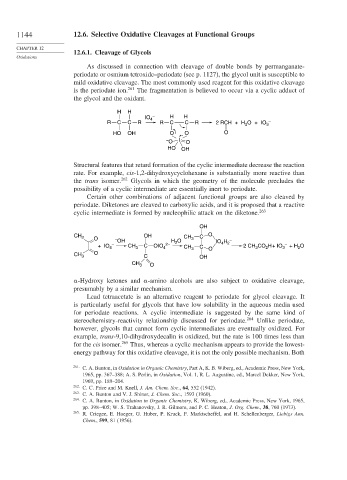Page 1168 - Advanced Organic Chemistry Part B - Reactions & Synthesis
P. 1168
1144 12.6. Selective Oxidative Cleavages at Functional Groups
CHAPTER 12
12.6.1. Cleavage of Glycols
Oxidations
As discussed in connection with cleavage of double bonds by permanganate-
periodate or osmium tetroxide–periodate (see p. 1127), the glycol unit is susceptible to
mild oxidative cleavage. The most commonly used reagent for this oxidative cleavage
is the periodate ion. 261 The fragmentation is believed to occur via a cyclic adduct of
the glycol and the oxidant.
H H
IO 4 – H H
R C C R R C C R 2 RCH + H O + IO 3 –
2
HO OH O O O
– O I O
HO OH
Structural features that retard formation of the cyclic intermediate decrease the reaction
rate. For example, cis-1,2-dihydroxycyclohexane is substantially more reactive than
the trans isomer. 262 Glycols in which the geometry of the molecule precludes the
possibility of a cyclic intermediate are essentially inert to periodate.
Certain other combinations of adjacent functional groups are also cleaved by
periodate. Diketones are cleaved to carboxylic acids, and it is proposed that a reactive
cyclic intermediate is formed by nucleophilic attack on the diketone. 263
OH
CH 3 O – OH CH 3 C O –
H
2
+IO 4 – OH CH 3 C OIO 4 2– H O CH 3 C O IO 4 2 2 CH CO HIO 3 – + H O
+
2
3
2
CH 3 O C OH
CH 3 O
-Hydroxy ketones and -amino alcohols are also subject to oxidative cleavage,
presumably by a similar mechanism.
Lead tetraacetate is an alternative reagent to periodate for glycol cleavage. It
is particularly useful for glycols that have low solubility in the aqueous media used
for periodate reactions. A cyclic intermediate is suggested by the same kind of
stereochemistry-reactivity relationship discussed for periodate. 264 Unlike periodate,
however, glycols that cannot form cyclic intermediates are eventually oxidized. For
example, trans-9,10-dihydroxydecalin is oxidized, but the rate is 100 times less than
for the cis isomer. 265 Thus, whereas a cyclic mechanism appears to provide the lowest-
energy pathway for this oxidative cleavage, it is not the only possible mechanism. Both
261 C. A. Bunton, in Oxidation in Organic Chemistry, Part A, K. B. Wiberg, ed., Academic Press, New York,
1965, pp. 367–388; A. S. Perlin, in Oxidation, Vol. 1, R. L. Augustine, ed., Marcel Dekker, New York,
1969, pp. 189–204.
262
C. C. Price and M. Knell, J. Am. Chem. Soc., 64, 552 (1942).
263 C. A. Bunton and V. J. Shiner, J. Chem. Soc., 1593 (1960).
264 C. A. Bunton, in Oxidation in Organic Chemistry, K. Wiberg, ed., Academic Press, New York, 1965,
pp. 398–405; W. S. Trahanovsky, J. R. Gilmore, and P. C. Heaton, J. Org. Chem., 38, 760 (1973).
265
R. Criegee, E. Hoeger, G. Huber, P. Kruck, F. Marktscheffel, and H. Schellenberger, Liebigs Ann.
Chem., 599, 81 (1956).

